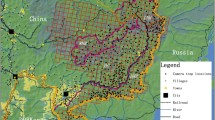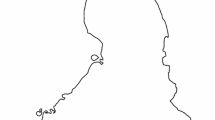Abstract
During a 6-year field study on the game farm ‘Benfontein’ in the central Republic of South Africa 1725 prey items were observed consumed by 17 free-ranging habituated black-footed catsFelis nigripes Burchell, 1824. Average prey size was 24.1 g. Eight males fed on significantly larger prey (27.9 g) than 9 females (20.8 g). Fifty-four prey species were classified by their average mass into 8 different size classes, 3 for mammals, 3 for birds, 1 for amphibians/reptiles, and 1 for invertebrates. Small mammals (5–40 g) constituted the most important prey class (39%) of total prey biomass followed by larger mammals (>100 g; 17%) and small birds (<40 g; 16%). Mammals and birds pooled comprised 72% and 26% of total prey biomass, respectively, whereas invertebrates and amphibians/reptiles combined constituted just 2% of total prey mass consumed. Three seasons of 4-months duration were recognized. Heterotherm prey items were unavailable during winter, when larger birds and mammals (> 100 g) were mainly consumed. Small rodents like the large-eared mouseMalacothrix typica, captured 595 times by both sexes, were particularly important during the reproductive season for females with kittens. Male black-footed cats showed less variation between prey size classes consumed among climatic seasons. This sex-specific difference in prey size consumption may help to reduce intra-specific competition.
Similar content being viewed by others
References
Acocks J. H. P. 1988. Veld types of South Africa. Memoirs Botanical Survey Southern Africa 40: 1–128.
Avenant N.L. and Nel J.A.J. 1998. Home-range use, activity, and density of caracal in relation to prey density. African Journal of Ecology 36: 347–359.
Bothma J du P. and Coertze, R.J. 2004. Motherhood increases hunting success in southern Kalahari leopards. Journal of Mammalogy 85: 756–760.
Corbett L. K. 1979. Feeding ecology and social organisation of wildcats (Felis silvestris) and domestic cats (Felis catus). PhD thesis, Aberdeen University, Aberdeen: 1–296.
Farrell L. E., Roman J. and Sunquist M. E. 2000. Dietary separation of sympatric carnivores identified by molecular analysis of scats. Molecular Ecology 9: 1583–1590.
Fritts S. H. and Sealander J. A. 1978. Diets of bobcats in Arkansas with special reference to age and sex differences. Journal of Wildlife Management 42: 533–539.
Funston P. J., Mills M. G. L. and Biggs H. C. 2001. Factors affecting the hunting success of male and female lions in the Kruger National Park. Journal of Zoology 253: 419–431.
Geertsema A. A. 1985. Aspects of the ecology of the servalLeptailurus serval in the Ngorongoro crater, Tanzania. Netherland Jounal of Zoology 35: 527–610.
Grassman L. I. 2000. Movements and diet of the leopard catPrionailurus bengalensis in a seasonal evergreen forest in south-central Thailand. Acta Theriologica 45: 421–426.
Grassman L. L, Tewes M. E., Silvy N. J. and Kreetiyutanont K. 2005. Spatial organization and diet of the leopard cat (Prionailurus bengalensis) in north-central Thailand. Journal of Zoology 266: 45–54.
Johnson W. E. and Franklin W. L. 1991. Feeding and spatial ecology of Felis geoffroyi in Southern Patagonia. Journal of Mammalogy 72: 815–820.
Kitchener A. 1991. The Natural History of the Wild Cats. Christopher Helm, London: 1–280.
Litvaitis J. A., Clark A. G. and Hunt J. H. 1986. Prey selection and fat deposits of bobcats (Felis rufus) during autumn in Maine. Journal of Mammalogy 66: 389–392.
Macdonald D. W. 1980. Patterns of scent marking with urine and feces amongst carnivore communities. Symposium of the Zoological Society of London 45: 107–139.
McLean G. L. 1985. Roberts’ Birds of Southern Africa. John Voelker Bird Book Fund, Cape Town: 1–848.
Moleón M. and Gil-Sánchez J. M. 2003. Food habits of the wildcat (Felis silvestris) in a peculiar habitat: the Mediterranean high mountain. Journal of Zoology, London 260: 17–22.
Molinari-Jobin A., Molinari P., Breitenmoser-Würsten C. and Breitenmoser U. 2002. Significance of lynxLynx lynx prédation for roe deerCapreolus capreolus and chamoisRupicapra rupicapra mortality in the Swiss Jura Mountains. Wildlife Biology 8: 109–115.
Molteno A. J., Sliwa A. and Richardson P. R. K. 1998. The role of scent marking in a free-ranging, female blackfooted cat (Felis nigripes). Journal of Zoology, London 245: 35–41.
Nowell K. and Jackson P. 1996. Wild cats: status survey and conservation action plan. IUCN, Gland: 1–382.
Olbricht G. and Sliwa A. 1997. In situ and ex situ observations and management of black-footed catsFelis nigripes. International Zoo Yearbook 35: 81–89.
Palomares F., Delibes M., Revilla M., Calzada J. and Fedriani J. M. 2001. Spatial ecology of the Iberian lynx and abundances of its primary prey, the European rabbit, in a heterogeneous environment. Wildlife Monographs 148: 1–36.
Palomares F., Godoy J. A., Piritz A., O’Brien J. O. and Johnson W. E. 2002. Faecal genetic analysis to determine the presence and distribution of elusive carnivores: design and feasibility for the Iberian lynx. Molecular Ecology 11: 2171–2182.
Rabinowitz A. 1990. Notes on the behavior and movements of leopard cats,Felis bengalensis, in a dry tropical forest mosaic in Thailand. Biotropica 22: 397–403.
Ross P. I. and Jalkotzy M. G. 1996. Cougar prédation on moose in south-western Alberta. Alces 32: 1–8.
Sakaguchi N. 1991. Habitat use of the Iriomote cat and changes in its response to prey availablility. [In: Wildlife conservation. N. Maruyama, B. Bobek, Y. Ono, W. Regelin, L. Bartos and P. Ratcliffe, eds]. Japan Wildlife Research Center, Tokyo: 137–140.
Sakaguchi N. and Ono Y. 1994. Seasonal change in the food habits of the Iriomote catFelis iriomotensis. Ecological Research 9: 167–174.
Sanderson J., Sunquist M. E. and Iriarte A. W. 2002. Natural history and landscape-use of guignas (Oncifelis guigna) on Isla Grande de Chiloe, Chile. Journal of Mammalogy 83: 608–613.
Schaller G. B. 1972. The Serengeti lion: a study of predator-prey relations. University of Chicago Press, Chicago: 1–480.
Schoener T. W. 1971. Theory of feeding strategies. Annual Review of Ecology and Systematics 2: 269–404.
Schulze R. E. and McGee O. S. 1978. Climatic indices and classifications in relation to the biogeography of southern Africa. [In: Biogeography and ecology of South Africa. M. J. A. Werger and W. Junk, eds]. The Hague: 19–52.
Siegel S. 1956. Nonparametric Statistics for the Behavioural Sciences. McGraw-Hill, New York: 1–312.
Skinner J. D. and Smithers R. H. N. 1990. The mammals of the Southern African Subregion. 2nd ed. University of Pretoria Press, Pretoria: 1–771.
Sliwa A. 1993. A habitat description and first data on ecology and behaviour of the black-footed cat (Felis nigripes) in the Kimberley area, South Africa. International Studbook for the Black-footed cat (Felis nigripes). Wuppertal 1993: 8–11.
Sliwa A. 1994. Diet and feeding behaviour of the black-footed cat (Felis nigripes Burchell, 1824) in the Kimberley Region, South Africa. Der Zoologische Garten 64: 83–96.
Sliwa A. 1996. A functional analysis of scent marking and mating behaviour in the aardwolf,Proteles cristatus (Sparrman, 1783). PhD thesis, University of Pretoria, Pretoria: 1–162.
Sliwa A. 2004. Home range size and social organization of black-footed cats (Felis nigripes). Mammalian Biology 69: 96–107.
Smithers R. H. N. 1971. The mammals of Botswana. Trustees of the National Museum, Salisbury: 1–340.
Sunquist M. E. 1981. The social organisation of tigers (Panthera tigris) in Royal Chitawan National Park, Nepal. Smithsonian Contributions to Zoology 336: 1–98.
Wang E. 2002. Diets of ocelots (Leopardus pardalis), margays (L. wiedii), and oncillas (L. tigrinus) in the Atlantic rainforest in southeast Brazil. Studies on Neotropical Fauna and Environment 37: 207–212.
Author information
Authors and Affiliations
Additional information
Associate Editor was Krzysztof Schmidt.
Rights and permissions
About this article
Cite this article
Alexander, S. Seasonal and sex-specific prey composition of black-footed catsFelis nigripes . Acta Theriol 51, 195–204 (2006). https://doi.org/10.1007/BF03192671
Received:
Accepted:
Issue Date:
DOI: https://doi.org/10.1007/BF03192671




